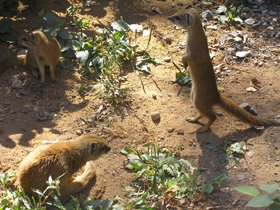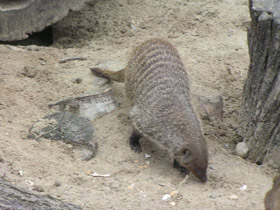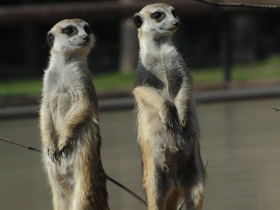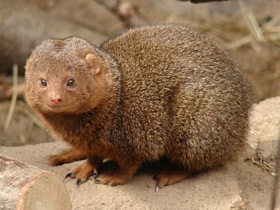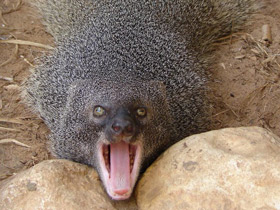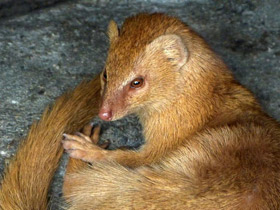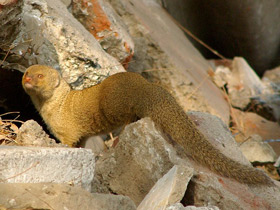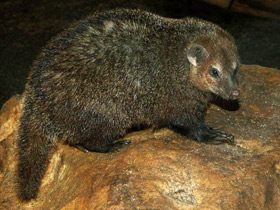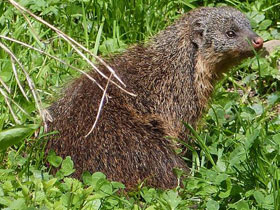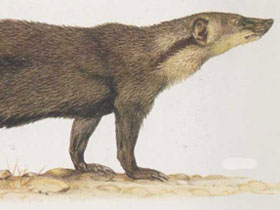Mongoose (the family Herpestidae)
A mongoose is a small terrestrial carnivorous mammal belonging to the family Herpestidae. This family is currently split into two subfamilies, the Herpestinae and the Mungotinae. The Herpestinae comprises 23 living species that are native to southern Europe, Africa and Asia, whereas the Mungotinae comprises 11 species native to Africa. The Herpestidae originated about 21.8 ± 3.6 million years ago in the Early Miocene and genetically diverged into two main genetic lineages between 19.1 and 18.5 ± 3.5 million years ago.
Etymology
The English word "mongoose" used to be spelled "mungoose" in the 18th and 19th centuries. The name is derived from names used in India for Herpestes species: muṅgūs or maṅgūs in classical Hindi; muṅgūs in Marathi; mungisa in Telugu; mungi, mungisi and munguli in Kannada.
The form of the English name (since 1698) was altered to its "-goose" ending by folk etymology. The plural form is "mongooses".
Origins and differences
Herpestidae are a family of placental mammals belonging to the order Carnivora, which includes 33 species inhabiting southern Eurasia and continental Africa, most of them called mongooses.
They are immune to king cobra venom, thanks to multiple anti-hemorrhagic and anti-neurotoxin antibodies present in their blood.
The Herpestidae are very close to the Viverridae and have long been placed in the same family. However, there are a number of anatomical, morphological, genetic and ethological differences between Herpestidae and Viverridae that make Herpestidae a separate family. The inner ear of Herpestidae differs slightly from the structure of Viverridae and their tympanic membrane has a very complex structure.
Most Herpestidae have an anal pouch covering the anal glands and anus. Unlike the Viverridae, all species of Herpestidae are entirely terrestrial and have non-tractile claws designed for digging, whereas most Viverridae have semi-tractile claws and their main purpose is to climb trees and catch prey. All Herpestidae are foot-breaking animals. In contrast, some Viverridae have semi-pedestrian limbs. In addition, Herpestidae have a reduced or absent membrane between the toes.
Herpestidae have horizontally elongated pupils, characteristic of herbivorous animals, while Viverridae have elliptical (vertical) or rounded pupils. The colouring of Herpestidae is usually monochromatic, in some species striped or mottled, but never as bright and contrasting as in some Viverridae.
Taxonomy
Herpestina was a scientific name proposed by Charles Lucien Bonaparte in 1845 who considered the mongooses a subfamily of the Viverridae. In 1864, John Edward Gray classified the mongooses into three subfamilies: Galidiinae, Herpestinae and Mungotinae. This grouping was supported by Reginald Innes Pocock in 1919, who referred to the family as "Mungotidae".
Genetic research based on nuclear and mitochondrial DNA analyses revealed that the Galidiinae are more closely related to Madagascar carnivores, including the fossa and Malagasy civet. Galidiinae is presently considered a subfamily of Eupleridae.
Classification
According to Mammal Species of the World the family consists of 14 genera and 33 species.
- Family Herpestidae:
- Genus Atilax:
- Atilax paludinosus;
- Genus Bdeogale:
- Bdeogale crassicauda;
- Bdeogale jacksoni;
- Bdeogale nigripes;
- Bdeogale omnivora;
- Genus Crossarchus:
- Crossarchus alexandri;
- Crossarchus ansorgei;
- Crossarchus obscurus;
- Crossarchus platycephalus;
- Genus Cynictis:
- Cynictis penicillata;
- Genus Dologale:
- Dologale dybowskii;
- Genus Galerella:
- Galerella flavescens;
- Galerella ochracea;
- Galerella pulverulenta;
- Galerella sanguinea;
- Genus Helogale:
- Helogale hirtula;
- Helogale parvula;
- Genus Herpestes:
- Herpestes brachyurus;
- Herpestes edwardsii;
- Herpestes fuscus;
- Herpestes ichneumon;
- Herpestes javanicus;
- Herpestes naso;
- Herpestes semitorquatus;
- Herpestes smithii;
- Herpestes urva;
- Herpestes vitticollis;
- Genus Ichneumia:
- Ichneumia albicauda;
- Genus Liberiictis:
- Liberiictis kuhni;
- Genus Mungos:
- Mungos gambianus;
- Mung mung bean;
- Genus Paracynictis:
- Paracynictis selousi;
- Genus Rhynchogale:
- Rhynchogale melleri;
- Genus Suricata:
- Meerkat Suricata suricatta.
Behaviour and ecology
Mongooses mostly feed on insects, crabs, earthworms, lizards, birds, and rodents. However, they also eat eggs and carrion.
Some species can learn simple tricks. They can be tamed and are kept as pets to control vermin.
Unlike the Viverridae, all species of Herpestidae are entirely terrestrial (although some species can climb trees) and have non-tractile claws designed for digging, whereas most Viverridae have semi-tractile claws and their main purpose is to climb trees and catch prey. All Herpestidae are foot-breaking animals. In contrast, some Viverridae have limbs that tend to be semi-pedal. The membrane between the toes is reduced or absent in Herpestidae.
Furthermore, unlike Viverridae, which are exclusively solitary, many species of Herpestidae form numerous groups or colonies.
Nutrition and peculiarities
Herpestidae, like Viverridae, are active predators, preferring animal food in one form or another. However, among the Viverridae there are species whose diet consists mainly of plant foods, whereas similar food preferences are not observed in the family Herpestidae.
Most Herpestidae stand on their hind legs, like some rodents (genus Rodenta), such as moles (genus Spermophilus), fully erect on their backs for better visibility (e.g. to see enemies). Viverridae do not exhibit this behaviour.

















